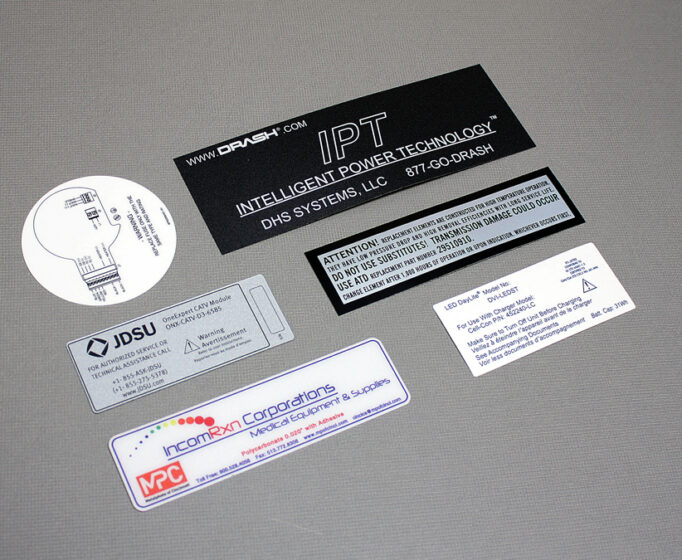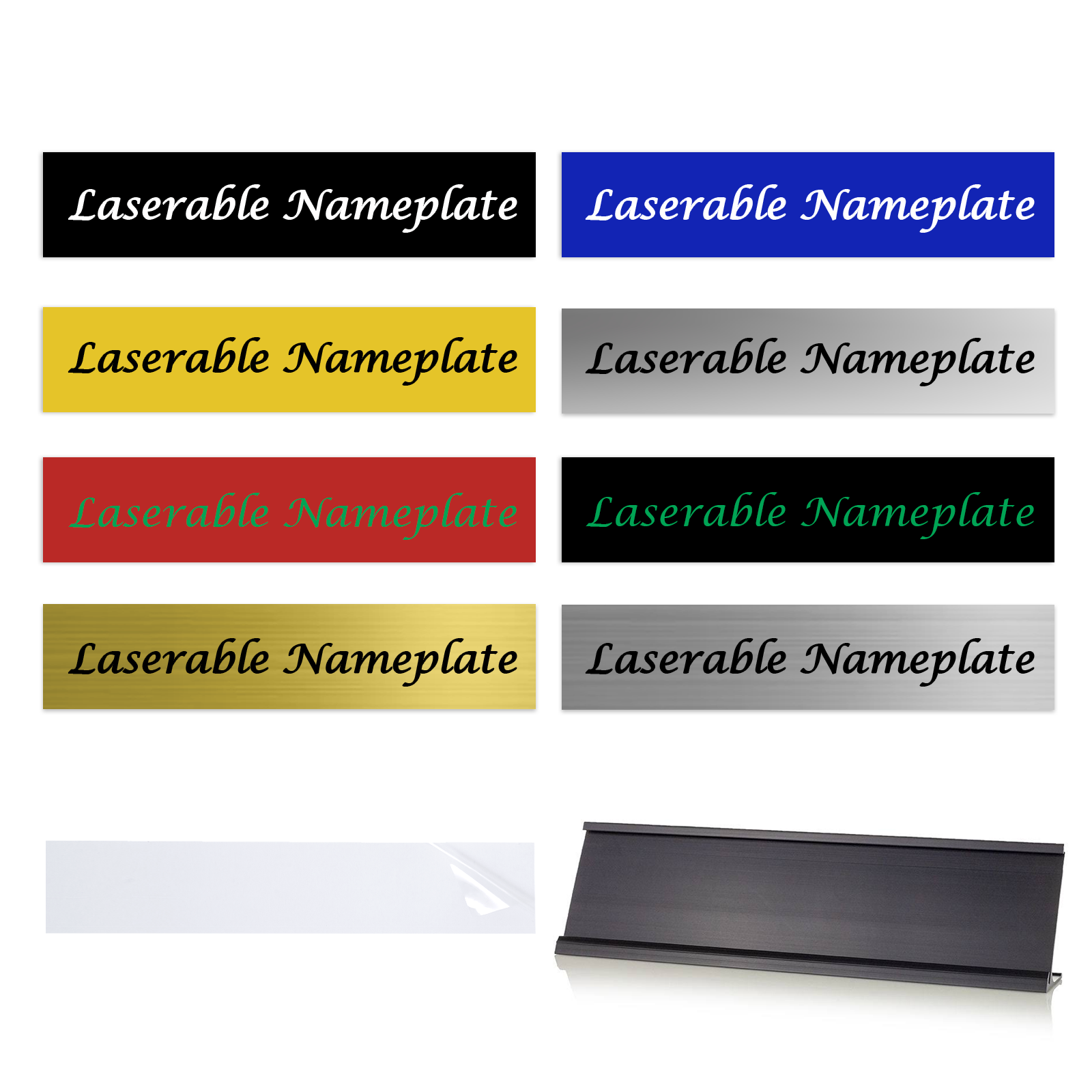How Plastic Nameplates Contribute to Lean Workflow and Productivity
How Plastic Nameplates Are Made: A Comprehensive Guide to Their Manufacturing Refine
The manufacturing of plastic nameplates entails a number of specific actions, beginning with the selection of appropriate products to the last finishing touches. Each stage is important, making certain the product meets details requirements for durability and looks. Various manufacturing strategies play a considerable role in crafting these nameplates. Understanding these procedures can drop light on the complexities behind what could appear like an easy item. What aspects add to the high quality and customization of these nameplates?
Comprehending Plastic Products Utilized for Nameplates

The Layout Refine: From Principle to Model
The design procedure for plastic nameplates starts with a clear principle that overviews the total production. Developers team up with customers to define the purpose, style, and certain requirements of the nameplate. This preliminary stage includes conceptualizing sessions, sketching ideas, and choosing shades and typefaces that line up with branding goals.Once the concept is developed, developers make use of computer-aided style (CAD) software program to produce thorough digital depictions. These prototypes enable for visualization and changes before moving on. Responses from stakeholders is important throughout this stage, as it helps improve the design to fulfill expectations.After wrapping up the electronic model, a physical version might be created, commonly with methods like 3D printing. This tangible depiction makes it possible for further assessment of visual appeals and capability. Overall, the design procedure is a crucial action that lays the foundation for the effective production of top notch plastic nameplates.
Reducing and Forming the Plastic
In the cutting and forming phase of plastic nameplate manufacturing, the option of materials plays a crucial role in determining the last product's high quality and durability (Plastic Nameplates). Numerous accuracy reducing strategies, such as laser cutting and CNC machining, warranty that the plastic is formed with precision and uniformity. This combination of cautious product selection and advanced cutting approaches is essential for creating top quality nameplates

Material Selection Refine
Selecting the right product is vital for producing top quality plastic nameplates. Different sorts of plastics are readily available, each offering distinct advantages and qualities. Usual choices include acrylic, polycarbonate, and PVC. Acrylic is preferred for its quality and UV resistance, making it ideal for outdoor applications. Polycarbonate, recognized for its longevity and influence resistance, is ideal for environments that call for enhanced security. PVC is commonly selected for its cost-effectiveness and adaptability in design. The choice process additionally thinks about elements such as thickness, surface, and shade surface, which can significantly affect the final appearance and functionality of the nameplate. Eventually, the picked material has to line up with the meant use and visual goals of the plastic nameplate.
Accuracy Trimming Techniques
While choosing the appropriate material lays the groundwork, accuracy cutting strategies play a necessary role fit the plastic nameplates right into their final kinds. Numerous methods, consisting of laser cutting, CNC milling, and pass away cutting, are employed to attain accuracy and uniformity. Laser cutting utilizes concentrated light to generate tidy edges and complex layouts, ideal for complex patterns. CNC milling provides adaptability by getting rid of excess product with accuracy, accommodating numerous densities and shapes. Die reducing, on the various other hand, allows for mass manufacturing of consistent pieces, improving efficiency. Each strategy is chosen based upon the style specs and the preferred finish, guaranteeing that the final item satisfies top quality requirements and customer expectations while preserving longevity and visual charm.
Printing Strategies for Customization
Just how can makers attain lively and exact designs on plastic nameplates? The answer depends on different printing methods tailored for customization. Digital printing has obtained appeal due to its capability to create high-resolution images and elaborate layouts directly onto plastic surface areas. This technique allows for fast turn-around times and very little setup costs, making it excellent for short runs and customized orders.Screen printing stays another widely utilized strategy, particularly for bigger amounts. It involves creating a stencil and using layers of ink, resulting in abundant colors and toughness. UV printing, which makes use of ultraviolet light to cure the ink, is also efficient, giving exceptional attachment and resistance to fading.Additionally, pad printing supplies adaptability for irregularly shaped nameplates, enabling for in-depth styles on tough surface areas. These printing approaches allow makers to fulfill varied customer needs while making certain quality and durability in their plastic nameplate products.
Surface Area Therapies and Finishing Options

Quality Assurance Procedures in Manufacturing
Ensuring the greatest requirements of high quality control throughout the production of plastic nameplates is necessary for keeping product stability and customer fulfillment. Makers execute rigorous assessment methods at different phases of the manufacturing process. At first, basic materials go through extensive testing to verify they satisfy specifications for durability and color consistency. Throughout the molding phase, automated systems check specifications such as temperature level and pressure to avoid defects.In addition, aesthetic inspections are conducted to recognize any type of surface blemishes or imbalances. Once the nameplates are produced, they are subjected to practical examinations, consisting of attachment tests for printed aspects and anxiety examinations for longevity. Quality control teams usually utilize statistical tasting techniques to evaluate sets, ensuring that any kind of deviations from criteria are quickly dealt with. This comprehensive strategy not just enhances item top quality but also cultivates trust with clients, attesting the producer's dedication to quality in every nameplate produced.
Product packaging and Distribution of Finished Nameplates
The product packaging and circulation of ended up plastic nameplates are vital action in guaranteeing they get to clients in excellent problem. Different packaging materials are picked to shield the nameplates throughout transportation, while shipping techniques are carefully chosen based on efficiency and cost-effectiveness. Furthermore, effective storage space remedies are applied to maintain quality till the nameplates are provided.
Packaging Materials Used
Choosing proper packaging go right here products is crucial to assure their protection during transportation when dispersing completed plastic nameplates. Frequently employed products consist of bubble cover, foam cushioning, and cardboard boxes, all designed to support the nameplates against effects and shocks. Bubble cover gives a versatile barrier, while foam cushioning warranties that nameplates stay safely in position, reducing the threat of scrapes or damage. Furthermore, strong cardboard boxes are used to contain the nameplates, supplying architectural support and protection from exterior components. Tags might be put on suggest handling directions or vulnerable components, better improving safety during transport. On the whole, using high-quality packaging materials substantially contributes to the honesty and discussion of the finished plastic nameplates upon arrival at their location.
Shipping Methods Used
Efficient circulation of ended up plastic nameplates relies on various delivery approaches that assure prompt and find more information safe and secure shipment. Business usually utilize copyright services, products delivery, and postal services, depending upon the dimension, weight, and location of the plans. For local deliveries, courier services offer quick transit, guaranteeing nameplates reach customers promptly. For larger orders, freight shipping is liked, making use of vehicles or delivery containers to transport bulk quantities efficiently. Post offices serve as a cost-effective choice for smaller sized shipments, particularly for domestic distributions. All delivery methods focus on safety packaging to avoid damages throughout transit. Tracking systems are likewise used to monitor deliveries, offering clients with real-time updates and confidence pertaining to the condition of their orders.
Storage Solutions Implemented

Often Asked Concerns
What Sorts Of Businesses Commonly Make Use Of Plastic Nameplates?
Plastic nameplates are frequently used by different companies, consisting of workplaces, manufacturing facilities, medical facilities, and schools. These nameplates offer vital functions such as recognition, information screen, and branding, adding to business efficiency and expert appearance throughout diverse atmospheres.
Just how Long Does the Entire Manufacturing Refine Take?
The production process duration varies based on intricacy and amount, usually varying from a few days to several weeks. Aspects affecting this timeline include design approval, product availability, and production techniques utilized by the business.
Can Plastic Nameplates Be Recycled After Use?
Plastic nameplates can be recycled, provided they are made from recyclable materials. The availability of reusing programs and neighborhood guidelines may impact their recyclability. Correct disposal techniques are important to ensure effective recycling.
What Are the Environmental Impacts of Plastic Nameplate Manufacturing?
The ecological effects of plastic nameplate production include carbon discharges, source deficiency, and air pollution from making procedures. Plastic Nameplates. Additionally, inappropriate click to read disposal adds to plastic waste, detrimentally impacting ecosystems and wild animals, highlighting the demand for lasting practices
Exist Any Kind Of Security Issues With Plastic Nameplates?
Safety and security worries pertaining to plastic nameplates mostly include potential chemical direct exposure throughout production and the risk of materials deteriorating in time, which may lead to dangerous materials being released, affecting both human wellness and the environment. While various products can be utilized for nameplates, plastic remains a popular choice due to its versatility and longevity. In the cutting and forming stage of plastic nameplate manufacturing, the option of products plays a necessary function in determining the last item's top quality and sturdiness. Selecting the ideal material is essential for producing high-grade plastic nameplates. While choosing the appropriate product lays the groundwork, accuracy cutting strategies play an important duty in shaping the plastic nameplates right into their last kinds. When dispersing completed plastic nameplates, picking ideal packaging materials is necessary to ensure their security throughout transit.